SAN JUAN COUNTY, Utah – Terry Whitehat remembers gathering at the community hall in Navajo Mountain each election day, where Navajo Nation members in this remote Utah community would cast their ballots.
Editor’s note:
This story was produced by the Walter Cronkite School-based Carnegie-Knight News21 “Voting Wars” national reporting project.
The tribal members would catch up with friends and family and eat food under the cottonwood trees in the parking lot.
So when Whitehat, a social worker who has lived most of his life on the reservation, received a ballot in the mail for the 2014 elections, he said it caught him off guard.
The county began conducting elections by mail in 2014. Members of the Navajo Nation who live in the area could no longer physically vote in the village. If they wanted to vote in person, they would have to drive to the only remaining polling place at the county seat in Monticello, a 400-mile round trip from Navajo Mountain.
Whitehat and a half-dozen other Navajo community members, along with the Navajo Nation Human Rights Commission, sued the county. They claimed the move to a mail-only election disenfranchised Native Americans, especially those who don’t read or speak English and had limited access to mail. They said it also violated the Voting Rights Act and the 14th Amendment.
Across the country, other tribal members have filed similar suits alleging that state laws and county election practices intentionally make it harder to vote on reservations. Local jurisdictions don’t always provide translators or polling locations on reservations, and tougher state voter identification laws have created problems for those who don’t have birth certificates or only have tribal ID.
“Native Americans have been the victim of the political process since the creation of the United States,” said OJ Semans, a retired police officer turned Native American voting rights crusader in South Dakota. “What we need to do is organize in order to protect what our ancestors passed on to us.”
“But it’s hard to do when everything you’re trying to have your people participate in, they put stumbling blocks,” Semans added.
Despite gaining the rights to citizenship and voting in 1924 from the federal government, Native Americans in some states could not vote until 1962. Those who live on reservations have consistently dealt with distances and language barriers when it comes to voting. But experts who have studied Native American voting rights said recent changes to legal requirements and provisions for voting have exacerbated those problems.
After the U.S. Supreme Court rejected a key provision of the Voting Rights Act in 2013, states and jurisdictions with histories of discrimination no longer needed to obtain clearance from the U.S. Department of Justice before making changes to the voting process.
The provision had covered Alaska and Arizona, two states with high Native American populations, as well as two reservations in South Dakota. Since the ruling, attorneys have filed lawsuits over voting changes affecting Native Americans in all three states.
Patty Ferguson-Bohnee, director of the Indian Legal Clinic at Arizona State University’s Sandra Day O’Connor College of Law, has worked on voting rights litigation with Native American nations and advocacy groups for years. She said policymakers simply don’t consider how conditions in some Native American communities pose barriers to voting that wouldn’t cause problems in cities or towns with basic services.
“They don’t understand,” she told News21. “They just think everybody can just walk out to the mailbox, or make a telephone call, but life isn’t like that in a lot of places in Indian country.”
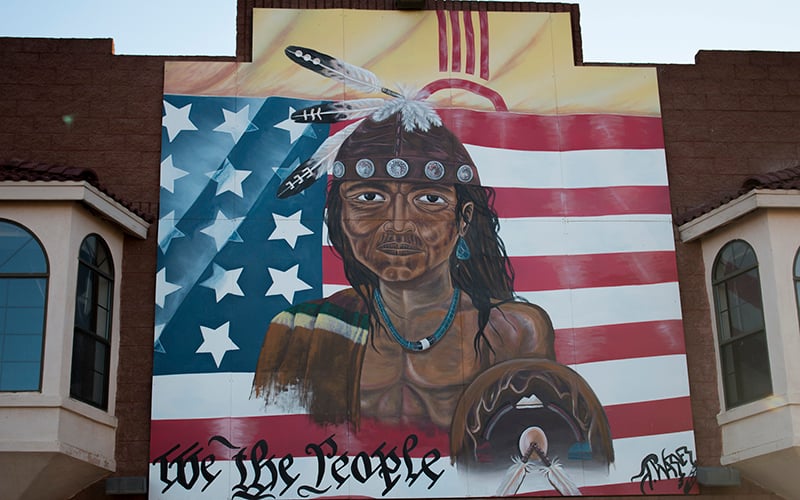
Mural of a Native American on the side of a trading post that sold goods from tribes on the Navajo Nation near Gallup, New Mexico. (Photo by Mike Lakusiak/News21)
Increasing influence
Native Americans have historically had some of the lowest turnout rates of any ethnic group in the country, according to several studies examining voter participation.
However, two recent studies by researchers at the University of Wyoming and the University of New Mexico indicated that voting among Native Americans has increased. The University of New Mexico study used U.S. Census Bureau data and found that in the 2008 general election, Native Americans were nearly 30 percent less likely to vote than non-Hispanic whites. However, in 2010 and 2012, there was virtually no difference between the two groups.
Researchers have attributed the change to various factors, including increases in educational attainment and higher incomes. The dynamic between Native American nations and government entities – from the local to federal levels – has shifted over time as Native American communities became more involved in issues such as the use of natural resources and gambling.
Jacqueline Pata, the executive director of the National Congress of American Indians, said Native Americans see the direct effects of federal policy on their lives. “That’s what pulls people to the polls for us,” Pata said. “Whether it be about Indian health care, or whether it be about the recognition of tribes and inclusion of tribes as governments.”
Studies have also found a correlation between voting and U.S. military service among Native Americans, who serve at a disproportionately high rate.
And although census figures show Native Americans only made up about 2 percent of the American population in 2014, academic experts argue they have greater influence than their numbers would suggest.
Daniel McCool, a professor at the University of Utah who studies Native American voting rights lawsuits, said it’s the concentration of the “Indian vote and their propensity to vote as a bloc that gives them power.”
Semans credited voters on the Pine Ridge and Rosebud Sioux reservations in South Dakota with helping to decide a 2002 U.S. Senate race. Tim Johnson, a Democrat, trailed Republican John Thune until the last ballots were tallied from the reservations on election night. Semans cites the race as the reason he and his wife began Four Directions, which has fought for voting equality on reservations across the U.S. for more than a decade.
Researchers predict the Native American vote will become even more important in future elections. The population increased nearly 27 percent between 2000 and 2010, and roughly a third of all Native Americans are under 18, according to the U.S. Census Bureau.
Legal resistance
Even though it appears Native American voter participation has increased as a whole, many challenges remain on reservations, where nearly a quarter of the population lives.
Since 2013, attorneys have filed at least six lawsuits about voting access for Native Americans. Since President Lyndon B. Johnson signed the Voting Rights Act into law in 1965, more than 90 lawsuits over Native American voting rights have been fought, McCool said. They largely fall into two categories: unequal access to voting on reservations, and changes to voting laws and procedures that target Native Americans, intentionally or not.
McCool, who catalogued decades of these lawsuits in a book, said Native Americans consistently sued for equal access to voting until the mid-1970s when officials expanded Voting Rights Act coverage to more states. He said the pre-clearance provision kept states and local authorities “from doing stupid things, some would say.”
He said that changed after the Supreme Court decision in 2013. “A lot of jurisdictions that had been afraid to engage in discriminatory practices were no longer afraid because there was no Justice Department watching them,” he said. “And so there has been a dramatic spike in cases, not just in Indian country, but all over.”
McCool said in most cases, Native Americans have won or settled cases in their favor. For example, after the lawsuit in San Juan County, officials agreed to open polls on the reservation for the November election. Cases in South Dakota prompted county officials to open satellite polling places on tribal land.
“When you’re winning 90 percent of the cases, that means something is wrong,” he said. “That means somebody has broken the law, and we see consistent violations of the Voting Rights Act.”
Ferguson-Bohnee said that filing a lawsuit in these cases is a last resort for Native American communities. “They’re very expensive, and they’re long, and the communities that are impacted don’t really have the resources to bring the lawsuit,” she said.
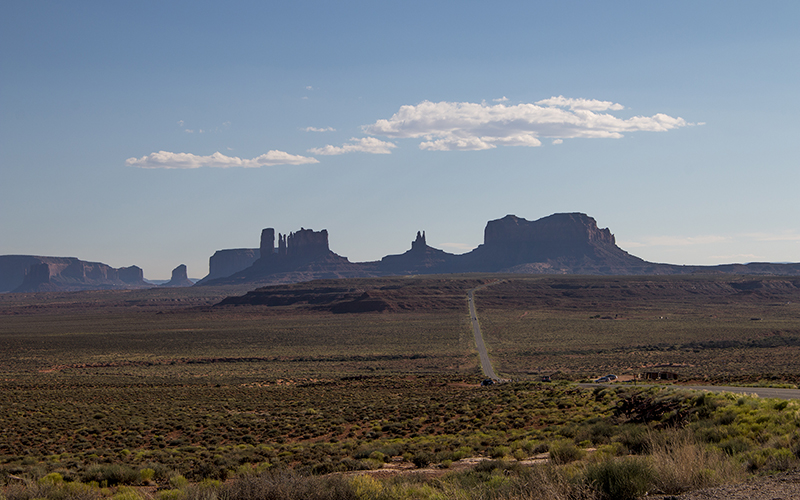
Nearly 200 miles separate Navajo Mountain from Monticello in San Juan County, Utah. The trip requires drivers to first travel south into Arizona before traveling north to the county seat. In between the two destinations rests Monument Valley Navajo Tribal Park. (Photo by Erin Vogel-Fox/News21)
Long distance, tense relationship
Native Americans make up about half of the roughly 15,000 residents of San Juan County, according to census data. Many lack access to reliable transportation, and residents face a poverty rate that’s twice the national average. Floods regularly wash out roads, and tribal members may have to drive well over an hour to get to the post office.
San Juan County includes part of the Navajo Nation, the largest Native American reservation in the country. The county has been engaged in a court battle for years over redistricting that prevented Navajo residents from receiving proportional representation. A judge ruled in the Navajo Nation’s favor in February.
When the county moved to voting by mail in 2014, officials closed polling locations in rural areas, including all six on the reservation, which disadvantaged Navajo-speaking residents, according to the 2016 lawsuit.
County officials said they moved to mail-in voting to increase voter turnout. However, turnout during general elections remained unchanged in 2014 compared with the previous off-year election in 2010, according to a News21 analysis of county data.
Many Navajos, especially elders, do not read or speak English well, Whitehat said. If they could not get someone they trust to translate their mail-in ballot for them, they would have to travel hundreds of miles to have ballots translated or vote in person with the aid of an interpreter. The only remaining polling place in 2014 was Monticello, 200 miles away from Navajo Mountain in the northern portion of the county, where the majority of white residents live, according to the lawsuit.
“My first reaction was ‘What about those people that don’t speak English?'” Whitehat said. “What happens to those people? How are they going to cast their vote? Who is going to help them?”
More than 160 miles away on the other side of the county, Kenneth Joe pulled up to the Montezuma Creek post office in a Chevy sedan, its plates reading “NDNJOE.” The retired teacher had stopped by on a June morning to check his mail. A pile of fliers and magazines spilled out. Joe tossed the junk into the wastebasket.
He explained that if someone can’t read or recognize the ballot in English, they may throw it away with the junk mail. “During an election year, you have all kinds of advertisements that come to you from all the candidates,” he said. “It becomes a big pile, so generally people pick up their mail and stick it straight into the trash.”
Only 25 percent of the county’s residents have an address and mail delivery to their homes, according to court documents. Instead, they rely on post office boxes in town. Because of the distance, many residents pick up their mail once a month, according to the lawsuit. And when the county gives residents about three weeks to fill out and return their ballots, that poses a problem.
“There’s a lot of difficulties with the mail-in,” Joe said. “A lot of times, the mail is late or we send the ballot back either a day late or a couple of days late, and they don’t accept those.”
Ryan Benally, who works for the Utah Navajo Trust Fund and has been involved in election campaigns in the county, said he believes the change was positive. His mother, Rebecca Benally, became the first Navajo woman elected county commissioner in San Juan County in the first election to use mail-in ballots. The district she now represents is predominantly on the Navajo reservation.
“It’s working,” he said. “The campaign my mother ran is a direct result of that process working. To say that their voting rights are suppressed, I just can’t see that with the data available.”
Jesse Trentadue, a lawyer defending the county in the lawsuit, said that while San Juan County is the largest in the state, it has a relatively small, dispersed population.
“Delivering services is almost a nightmare,” Trentadue said. “When you have that few people, you don’t have a huge tax base either. Ideally, if you had all the money in the world, you could have a poll at everybody’s house. But that is not possible.”
The decision to bring back polling locations, including Navajo Mountain, came only after the U.S. Department of Justice began an investigation into mail-in voting in San Juan County and a judge issued a temporary injunction ordering the county to reopen polling places on the reservation.
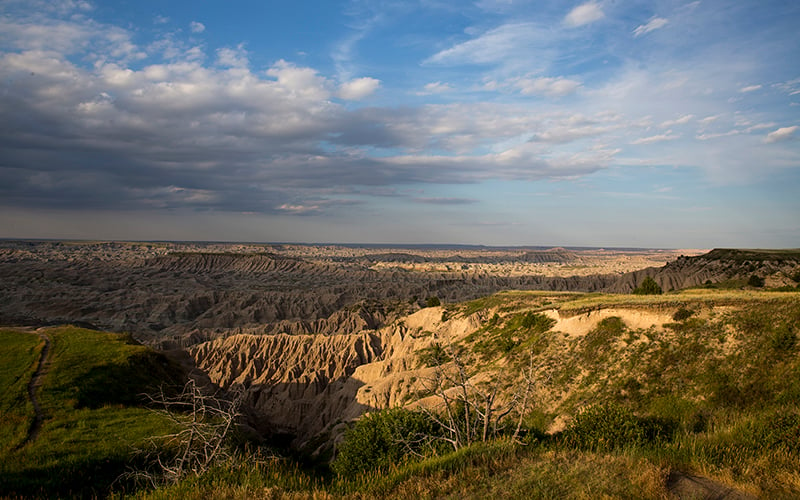
Part of the Badlands National Park crosses into the Pine Ridge Reservation within Oglala Lakota County in South Dakota. (Photo by Mike Lakusiak/News21)
Fighting for polls
The Pine Ridge reservation in South Dakota was the poorest area in the U.S. in 2014. The reservation is vast and sparsely populated, with little land fit for agriculture. Badlands National Park covers the northwest corner of the reservation.
There is a long history of litigation over voting rights on reservations in South Dakota, especially in Pine Ridge. It took a lawsuit in 1975 for residents of part of Pine Ridge to be able to vote for county officials, and four suits have been filed over access to voting on the reservation by Native American plaintiffs since 2005.
Tom Poor Bear, vice president of the Oglala Sioux Tribe, and other residents of the portion of Pine Ridge that falls within Jackson County filed the most recent suit in 2014, arguing that Native American residents had to travel about twice as far to register and vote early than the county’s white residents because there were no early voting locations on the reservation.
The county eventually used federal funds to open an early voting place in 2016.
A neighboring county faced a nearly identical lawsuit two years prior.
In 2012, 25 members of the Oglala Lakota tribe brought a lawsuit against the South Dakota secretary of state and Fall River County, which runs elections for Oglala Lakota County.
Fall River County Auditor Sue Ganje, a defendant in the lawsuit, said those living on the Oglala Lakota County part of the reservation would have to drive to the Fall River courthouse to register or vote early. The journey could be more than 100 miles for some.
County officials had said they didn’t have enough money to open a satellite office. However, the Help America Vote Act, which provides federal funds for states to conduct accurate and fair elections, can provide money in these situations, according to the lawsuit.
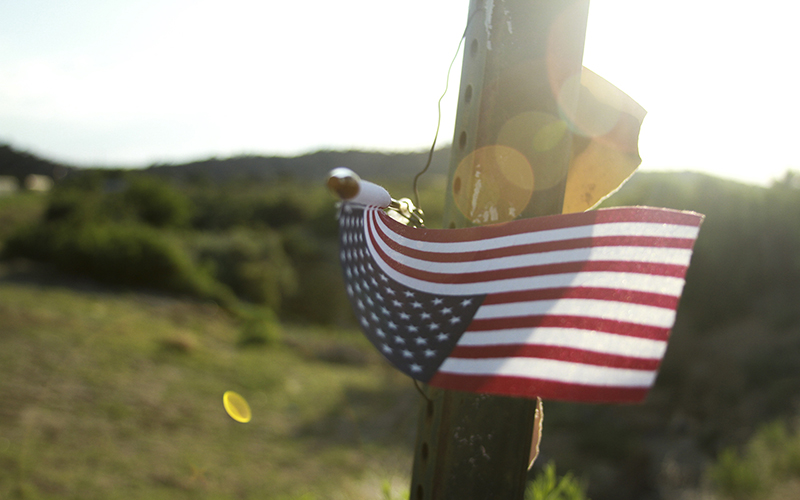
A small American flag hangs from the post of a stop sign near the Tsé Kichíí (Red Rock) chapter house near Gallup, New Mexico. (Marianna Hauglie/News21)
The secretary of state distributed the federal funds, and officials opened early voting locations during the 2014 election.
Ganje said she holds no ill will toward those on the reservation.
“It’s all for the people down there,” she said. “The lawsuit has bettered their opportunities down there.”
Semans is working with other Native American communities nationwide to ensure they can have early voting locations on reservations. He said his organization recently helped open offices on three reservations in Minnesota without litigation.
Semans put the importance of satellite polling locations in basic terms. “You can go 5 miles instead of 100 miles,” he said. “Any normal person would say, ‘You know what, that makes sense.'”
Tougher laws
Arizona has the third-largest Native American population in the country. The 22 tribes in Arizona cover about a quarter of the state’s land.
Native Americans in Arizona have long struggled with voting restrictions, including a literacy test at the polls until 1972, which prevented some Native Americans from voting.
In the latest battle, the Democratic National Committee and a group of voters representing several minority groups, including Native Americans, sued the state and Maricopa County – the state’s largest county.
The lawsuit accuses officials of voter suppression after the county drastically reduced the number of polling places, and people waited for hours to cast their ballots in the March 22 presidential preference election.
The state also passed a law making so-called ballot harvesting – when people collect marked ballots for others and return them to elections officials – a felony. Peterson Zah, former president of the Navajo Nation, said the new restrictions will make it more difficult for the 100,000 members of the Navajo Nation in Arizona to vote.
Lenora Fulton, the Apache County recorder, said many rural residents on the reservation collect ballots from their neighbors and drop them off when they drive to town.
The lawsuit asks the U.S. District Court for an injunction to block the law from taking effect.
The suit also aims to force elections officials to count out-of-precinct provisional ballots. The plaintiffs claimed the state rejected a disproportionate number of provisional ballots cast by Native Americans.
Other Arizona laws have also drawn criticism for their effect on Native American voters. Confusion about acceptable forms of voter identification, especially tribal ID, persist even though the state passed its voter ID law in 2004.
In a state election in May, Mikah Carlos, 22, said a poll worker stationed at the Salt River Pima-Maricopa Indian Community told her that they could not accept tribal ID cards to vote. Carlos, a member of the community’s youth council, said she cast her ballot only after other poll workers came over to help.
Carlos said the poll worker, who wasn’t Native American, should have received better training – the state law allows many forms of tribal ID.
Fulton, a member of the Navajo Nation, said it helps when tribal members work at the polls. “People from the community know the area and culture and know how to address the public. If someone is frustrated, they can talk to them in their own language,” Fulton said. “If there’s a stranger in their midst, people get apprehensive.”
Leonard Gorman, executive director of the Navajo Nation Human Rights Commission, said Native Americans fight a constant battle over voting rights. “As we get to a plateau where we believe we’ve achieved something, the rules of the game change,” he said.
Reaching out
Even without the barriers to vote, it’s hard to make voting a priority for many Native Americans because they often have more pressing things to worry about, Semans said.
“Even here on Rosebud, you wake up in the morning, you’re not thinking about who the president is,” he said. “You’re thinking about survival.”
Wizipan Little Elk, the outreach director for Four Directions, said Native Americans have a lot at stake when it comes to elections, making it even more imperative that they have a voice through voting.
“American Indians are the most highly regulated group of individuals in this country,” he said. “And despite the stereotypes, we do pay taxes and we have a vested interest overall in this economy and this country.”
“The quality of health care that we receive is dependent on federal appropriations and management of federal programs. We have in many senses a literal life-or-death interest in these issues.”
The National Council of American Indians operates Native Vote, a national nonpartisan initiative to mobilize Native voters both on and off reservations and advocate for their voting rights. Pata, with the National Council of American Indians, said she hopes to see more engagement among communities this election.
“This year is going to be extremely important for us to be very engaged, and I don’t think we are in a position to do that at this point,” Pata said. “More than ever, our tribal issues are on the table right now. We’ve got to show that we care and that we are going to show up and vote.”
On the Lake Traverse reservation on the northeast corner of South Dakota, the Sisseton Wahpeton Oyate tribe held its 149th annual Wacipi – commonly referred to as a powwow – on the Fourth of July weekend. Dustina Gill and volunteers from the community conducted voter registration, focusing on the younger crowd outside of the arena as drums pounded in the background.
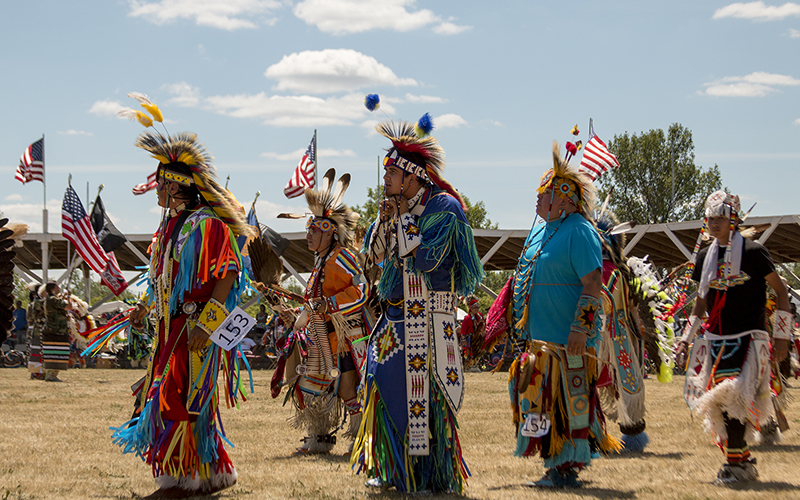
The Sisseton Wahpeton Oyate tribe conducted its 149th annual Wacipi, also known as a powwow, during the Fourth of July weekend in South Dakota. It is the second-oldest Wacipi in the nation. The tribe chose this date because at the time it was illegal for them to practice their religious ceremonies because they spoke another language. They could pass off their cultural celebration as a Fourth of July festivity. (Mike Lakusiak/News21)
Richard LaRoque, a member of Sisseton Wahpeton who lived out of state for several years, registered for a second time after his first form came back rejected. He said he would not have tried again had he not run into Gill. “I’ve never actually had a problem voting before,” LaRoque said. “But, at the same time, I’ve never tried to register to vote on a reservation before.”
Gill has done voter registration throughout the state and said she encountered the same barriers to voting in many communities, where the drive to vote could take a full tank of gas. “I felt so bad,” she said. “Voting’s a luxury people can’t afford.”
As the sun set that Saturday, Gill and another volunteer called after some teenagers asking them if they’re 18 and whether they’ve registered to vote.
Gill said that if Native Americans vote in numbers, they can make a real difference for the next generation. “We’re a sleeping giant,” she said. “And we’ll wake up.”
Reporting for this story was done in collaboration with DecodeDC, a podcast produced at the Scripps Washington Bureau.
Editor’s note: A previous version of this story incorrectly identified a Native American organization. Jacqueline Pata is the executive director of the National Congress of American Indians. The group also operates Native Vote.